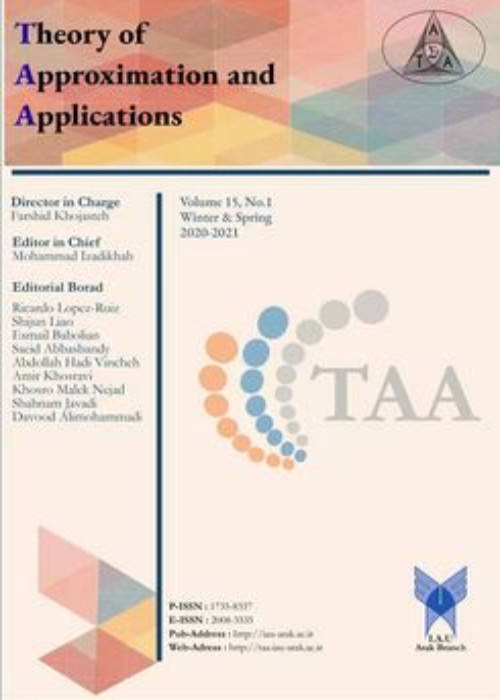فهرست مطالب
Theory of Approximation and Applications
Volume:3 Issue: 1, Winter and Spring 2007
- تاریخ انتشار: 1386/06/15
- تعداد عناوین: 8
-
Digitals of Real NumbersPage 1In [1], - parts of real numbers, and some of its properties are introduced. In this article the properties of - parts are studied from the viewpoint of Elementary, and Analytic Number Theory, and their relations to the unique representation of real numbers to the base are discussed. In this way, some fundamental theorems such as the finite, and infinite representation of real numbers to the base, which are generalizations of the ordinary representation to the base of a natural number, are stated and proved.
-
A Modern Application for SILP ProblemsPage 2In this article after introducing the convergence method, an optimal control problem in which it is changed into SILP problem by using embedding method, is solved via convergence approach. For this reason, by using a fixed discretization, the number of variables is fixed. An approximated solution of original problem is existed from the solution of a finite linear programming. Rubio has shown that this approximation works much better when the number of constrains are increased. Hence one can obtain a sequence of (nearly) optimal solution of FLP problems which converges to optimal solution for SILP problems. BY using this idea, we obtain the optimal solution and control for the mentioned system, numerically.
-
Growth Low and Pay by Installments by Stairs FormPage 3In the present article, using a growth law with a constant coefficient growth () of a formula for loan installments with equal installments and some of its problems are dealt with. Problems such as 1) the false effect of inflation on the interest of the loan for the receiver of loan.2) the primary pressure of cumbersome installments on the receiver of lon.3) the waste of time and workforce on the part of both the giver and receiver of loan for returning trivial final installments. Using a growth formula with an inconstant growth coefficient (), we can make stairs installments possible. In this case, returning of the loan starts with smaller installments in initial months and continues with greater installments in later years. Then, the advantages of this formula over the conventional one are presented. The most important advantages are as follows: 1) the real effect of inflation on the rate of interest. 2) Returning of the loan with a specified number of installments.3) Returning of the loan with a specified amount of installments 4) Returning of the loan in a specified time. It should be noted that the four above-mentioned items exist in the conventional formula as well. However, these items enjoy a much higher flexibility in stairs installments.
-
A Survey on Approximate Inverse PreconditionPage 4The standard incomplete LU (ILU) preconditioners often fail for general spares indefinite matrices because they give rise to unstable factors L and U. In such cases it may attractive to approximate the inverse of the matrix directly. This paper focuses on approximate inverse preconditioners based on minimizing where AM is the preconditioned matrix. An iterative descent type method is used to approximate each column of the inverse. For this approach to be efficient, the iteration must be done in sparse mode. Numerical dropping is applied to each column to maintain sparsity in the approximate inverse. This paper discusses options such as Newton and global, self-preconditioning and dropping methods. The performance of the options are compared on standard problems, Theoretical results on general approximate inverse for algorithms are derived.
-
Solving Fuzzy Linear System by LU - factorizationsPage 5In this paper, we study a Fuzzy linear system to form. Where A is crisp matrix and b is fuzzy vector. We show that coefficient matrix A has LU - factorizations where L is nonsingular lower triangular matrix and U is matrix rank revealing minimal canonical form. We replace this system by two crisp systems and by solving these crisp systems, we obtain fuzzy solutions of fuzzy linear system (1). Some examples are presented to illustrate this method.
-
Implementation of effective order SIRKPage 6In this paper, Singly implicit Runge-Kutta(SIRK) introduced. This method has two important advantage stability& low implementation cost. Restrictions stability for s>2 bring about approximation calculations go beyond interval [0, 1]. The concept of effective order and implementation of Effective order SIRK (ESIRK) not only over come this disadvantage but also keeps accuracy & stability of SIRK method.
-
Derivations on Commutative RingsPage 7We show that if R is a finitely generated algebra over a field and is a derivation, then d leaves invariant the minimal singular primes of R. Also we show that if R is suitably restricted then d leaves invariant the minimal singular primes for i=0,1,2,….
-
Some of non linear time series models and applicationsPage 8Non-linear time series analysis is rapidly developing subject. Of necessity it drowses on deeper aspect of probability theory and more sophisticated tools of statistical inference. In this paper we investigate that a time series is linear or non-linear, and then the analysis of time series is done. First we introduce a general topic of time series such as: time series model building, stationary, linear models, and analysis of linear models. Then some of non-linear time series models such as: non-linear autoregressive model, Exponential AR Model, random coefficient ARMA model, bilinear model and so on is introduced. In continue we study: some of advantages and some of limitations of ARMA models, statistical concepts, graphical methods, tests for linearity, model selection, Akaikes approach for model selection, diagnostic checks. In Finale we analysis sunspot data that consists of monthly mean sunspot numbers from Jan 1975 to dec 2001.


